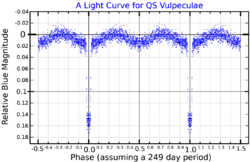Astronomy:22 Vulpeculae
| Observation data Equinox J2000.0]] (ICRS) | |
|---|---|
| Constellation | Vulpecula |
| Right ascension | 20h 15m 30.2386s[2] |
| Declination | +23° 30′ 32.051″[2] |
| Apparent magnitude (V) | 5.15[3] |
| Characteristics | |
| Spectral type | G9Ib-II + B8V[4] |
| U−B color index | +1.03[5] |
| B−V color index | +0.68[5] |
| Variable type | Algol[3] |
| Astrometry | |
| Radial velocity (Rv) | −22.8±0.9[6] km/s |
| Proper motion (μ) | RA: 2.852±0.067[2] mas/yr Dec.: −7.278±0.071[2] mas/yr |
| Parallax (π) | 2.1872 ± 0.0850[2] mas |
| Distance | 1,490 ± 60 ly (460 ± 20 pc) |
| Absolute magnitude (MV) | −3.67[7] (−3.5 / −0.1)[8] |
| Orbit[4] | |
| Period (P) | 249.18±0.010 d |
| Eccentricity (e) | 0.011 |
| Inclination (i) | 81.34±0.02[1]° |
| Argument of periastron (ω) (secondary) | 0 (assumed)° |
| Semi-amplitude (K1) (primary) | 27.10±0.21 km/s |
| Semi-amplitude (K2) (secondary) | 40.0±1.0 km/s |
| Details | |
| 22 Vul A | |
| Mass | 4.649[4] M☉ |
| Radius | 96[4] R☉ |
| Luminosity | 2,188[1] L☉ |
| Temperature | 4,699[4] K |
| Rotation | 142 - 165 days[1] |
| Rotational velocity (v sin i) | 16 - 20[1] km/s |
| 22 Vul B | |
| Mass | 3.150[4] M☉ |
| Radius | 3.4[4] R☉ |
| Luminosity | 123[1] L☉ |
| Temperature | 11,995[4] K |
| Age | 135.1[4] Myr |
| Other designations | |
| Database references | |
| SIMBAD | data |
22 Vulpeculae is a binary star system in the northern constellation Vulpecula. Based on its parallax, it is located some 1,490 light-years away,[2] and it has an apparent magnitude of about 5.2, making it visible to the naked eye. The system is moving closer to the Earth with a heliocentric radial velocity of −23 km/s.
The pair have an orbital period of 249 d in an almost-circular orbit. The primary component is a G-type bright giant. It is over four times as massive as the Sun, and over 96 times as wide. Its companion is a B-type main-sequence star, 3.4 times as massive as the Sun.[8] Although the secondary has an effective temperature of nearly 12,000 K and the primary just 4,700 K, the large size of the cooler star means it is nearly 20 times as luminous at 2,200 L☉. The primary star is rotating slowly with a rotation period that appears to be between about 140 and 165 days, unexpectedly faster than the orbital period. Different parts of its atmosphere may be rotating at different speeds.[1] The hot secondary is rotating much faster, possibly at 350 km/s.[10]
The two stars have an orbit that is oriented in such a way that they periodically eclipse each other, each star alternately blocking the light of the other. For that, it has been given the variable star designation QS Vulpeculae;[9] 22 Vulpeculae is the Flamsteed designation. The maximum drop in visual apparent magnitude is 0.05 magnitudes when the hot secondary is completely hidden by the large cool primary. The eclipses are deeper at shorter wavelengths because a greater proportion of the short-wavelength radiation comes from the hot star. The primary eclipses last for eight days at visual wavelengths, but partial phases can be detected for up to 17 days at ultraviolet wavelengths due to the expanded atmosphere and wind of the primary star. Secondary eclipse, where the hot star transits the cooler one, are undetectable, and ellipsoidal variations due to distortion of the large primary produce brightness changes of less than 1.5%.[1]
References
- ↑ 1.0 1.1 1.2 1.3 1.4 1.5 1.6 1.7 Eaton, Joel A.; Shaw, Felecia G. (June 2007). "Properties of the ζ Aur-Type Binary System 22 Vul = QS Vul". The Astronomical Journal 133 (6): 2669–2678. doi:10.1086/512186. Bibcode: 2007AJ....133.2669E.
- ↑ 2.0 2.1 2.2 2.3 2.4 2.5 Brown, A. G. A. (2021). "Gaia Early Data Release 3: Summary of the contents and survey properties". Astronomy & Astrophysics 649: A1. doi:10.1051/0004-6361/202039657. Bibcode: 2021A&A...649A...1G. Gaia EDR3 record for this source at VizieR.
- ↑ 3.0 3.1 Samus, N. N. et al. (2009). "VizieR Online Data Catalog: General Catalogue of Variable Stars (Samus+ 2007-2013)". VizieR On-line Data Catalog: B/GCVS. Originally Published in: 2009yCat....102025S 1: B/gcvs. Bibcode: 2009yCat....102025S.
- ↑ 4.0 4.1 4.2 4.3 4.4 4.5 4.6 4.7 4.8 Eggleton, Peter P.; Yakut, Kadri (2017). "Models for 60 double-lined binaries containing giants". Monthly Notices of the Royal Astronomical Society 468 (3): 3533. doi:10.1093/mnras/stx598. Bibcode: 2017MNRAS.468.3533E.
- ↑ 5.0 5.1 Mermilliod, J.-C. (1986). "Compilation of Eggen's UBV data, transformed to UBV (unpublished)". Catalogue of Eggen's UBV Data. Bibcode: 1986EgUBV........0M.
- ↑ Wilson, Ralph Elmer (1953). "General catalogue of stellar radial velocities". Washington. Bibcode: 1953GCRV..C......0W.
- ↑ Gray, David F.; Pugh, Teznie (2012). "The Third Signature of Granulation in Bright-Giant and Supergiant Stars". The Astronomical Journal 143 (4): 92. doi:10.1088/0004-6256/143/4/92. Bibcode: 2012AJ....143...92G.
- ↑ 8.0 8.1 Schroeder, K.-P.; Griffin, R. E. M.; Hunsch, M. (1994). "Optical spectra of zeta Aurigae binary systems. 6: The chromosphere of 22 Vulpeculae". Astronomy and Astrophysics 288 (1): 273–281. Bibcode: 1994A&A...288..273S.
- ↑ 9.0 9.1 "* 22 Vul". SIMBAD. Centre de données astronomiques de Strasbourg. http://simbad.u-strasbg.fr/simbad/sim-basic?Ident=%2A+22+Vul.
- ↑ Griffin, R. E. M. et al. (July 1993). "Optical spectra of zeta Aurigae binary systems. V. The 1988 eclipse of 22 Vulpeculae.". Astronomy and Astrophysics 274: 225. Bibcode: 1993A&A...274..225G.
 |


